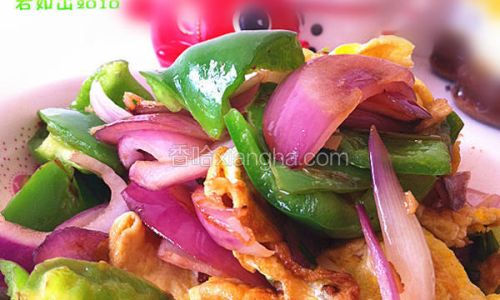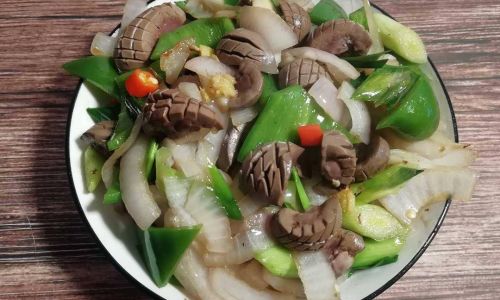Introduction
Stir-fried eggs with bell peppers and onions is a classic dish that bridges simplicity and flavor, embodying the essence of home-cooked comfort. This vibrant, colorful meal is a staple in many households worldwide, celebrated for its quick preparation time, minimal ingredient list, and adaptable taste profile. Whether you’re a novice cook or a seasoned chef, this recipe offers a canvas to experiment with textures, seasonings, and presentation. In this comprehensive guide, we will explore the nuances of crafting this dish to perfection, from selecting the freshest produce to mastering the stir-fry technique. By the end, you’ll not only have a recipe to replicate but also the confidence to innovate and make it your own.
The Humble Beginnings of a Timeless Dish
Before diving into the cooking process, let’s appreciate the cultural tapestry woven into this seemingly ordinary meal. Stir-frying, a cornerstone of Asian cuisine, prioritizes high heat, quick cooking, and the preservation of ingredients’ natural flavors. Eggs, a universal symbol of nourishment, pair harmoniously with the sweet crunch of onions and the mild, refreshing bite of bell peppers. This trio creates a symphony of flavors and textures that transcends geographical boundaries. While the dish’s origins are rooted in frugality—a way to stretch ingredients into a satisfying meal—it has evolved into a beloved classic enjoyed in kitchens from Beijing to Boston.
Ingredients: Quality Over Quantity
The beauty of this recipe lies in its simplicity, but that simplicity demands attention to ingredient quality. Let’s break down each component:

- Eggs (4 large): Opt for fresh, free-range eggs if possible. Their rich yolks and robust flavor elevate the dish. For a luxurious twist, consider duck eggs, which offer a creamier texture.
- Bell Peppers (2 medium, ideally a mix of red, yellow, and green): Each color imparts a subtle flavor variation. Red peppers are sweetest, green peppers have a grassy undertone, and yellow peppers balance the two. Avoid overripe peppers, which may turn mushy during cooking.
- Onions (1 medium, yellow or white): Yellow onions provide a balanced sweetness, while white onions offer a sharper bite. For a milder flavor, soak sliced onions in cold water for 10 minutes before cooking.
- Cooking Oil (2 tbsp): Neutral oils like vegetable or canola work best to avoid overpowering the dish. For a nutty twist, try sesame oil as a finishing touch.
- Salt and Pepper (to taste): Use kosher salt for even seasoning and freshly ground black pepper for aromatic complexity.
- Optional Additions: Soy sauce (1 tsp for umami depth), a splash of rice vinegar (to brighten flavors), or a handful of chopped cilantro (for garnish) can elevate the dish.
Preparation: The Foundation of Flavor
-
Mise en Place:
- Eggs: Crack them into a bowl, add a pinch of salt, and whisk vigorously until frothy. This incorporates air, ensuring fluffy scrambled eggs.
- Bell Peppers: Remove stems, seeds, and membranes. Slice into thin strips or small dice for even cooking.
- Onions: Halve and thinly slice lengthwise for elegant, uniform rings.
- Aromatics (optional): Mince 2 garlic cloves or a thumb-sized piece of ginger for an extra layer of flavor.
-
Equipment Check:
- A well-seasoned carbon steel or cast-iron wok is ideal for high-heat stir-frying, but a large nonstick skillet works too.
- Ensure your spatula is heat-resistant and sturdy enough to scrape the pan’s surface without damaging it.
Cooking Technique: The Dance of Heat and Motion
-
Preheat the Pan:
Place your wok or skillet over medium-high heat. Allow it to warm for 2–3 minutes until a drop of water evaporates instantly. This ensures even cooking and prevents sticking.
-
Sauté the Aromatics (Optional):
Add 1 tbsp of oil to the hot pan. Toss in garlic or ginger and stir-fry for 30 seconds until fragrant. This step infuses the oil with aromatic oils, laying the dish’s flavor foundation. -
Cook the Onions and Peppers:
- Add the remaining 1 tbsp of oil and the onions. Sauté for 2–3 minutes until translucent.
- Toss in the bell peppers and stir-fry for an additional 3–4 minutes. The goal is to soften the vegetables slightly while retaining their vibrant color and crispness. Avoid overcooking, which can lead to a soggy texture.
-
Introduce the Eggs:
- Reduce the heat to medium. Pour the whisked eggs evenly over the vegetables.
- Allow the eggs to set for 20–30 seconds before gently folding them into the vegetables using a spatula. This creates large, tender curds rather than small, dry pieces.
-
Season and Finish:
- Sprinkle salt and pepper generously. For added depth, drizzle soy sauce around the pan’s edge (the residual heat will caramelize it slightly).
- Toss everything together for another minute until the eggs are fully cooked but still moist. Remove from heat immediately to prevent overcooking.
Serving Suggestions: Beyond the Basic Bowl
This dish’s versatility shines in its pairing options:

- Breakfast Classic: Serve with crusty toast or a side of avocado for a protein-packed morning meal.
- Lunchtime Delight: Wrap in a warm tortilla with salsa for a handheld treat.
- Dinner Star: Pair with steamed rice, quinoa, or noodles. Add a side of kimchi or pickled vegetables for a tangy contrast.
- Appetizer Innovation: Stuff into lettuce cups and garnish with sesame seeds for a bite-sized canapé.
Customization: Making It Your Own
The beauty of this recipe lies in its adaptability. Here are creative twists to explore:
- Spice It Up: Add a sliced chili pepper or a dash of sriracha during cooking.
- Cheese Lover’s Dream: Sprinkle grated Parmesan or crumbled feta over the finished dish.
- Protein Boost: Toss in cooked shrimp, diced tofu, or leftover chicken for a heartier meal.
- Herb Infusion: Experiment with basil, dill, or mint for a fresh, aromatic finish.
Troubleshooting: Common Pitfalls and Solutions
-
Watery Eggs:
Ensure your pan is hot enough before adding the eggs. Overcrowding the pan can also lead to steaming instead of frying. -
Burnt Vegetables:
Cut vegetables into uniform sizes for even cooking. If your stove runs hot, reduce the heat slightly during sautéing. -
Rubbery Eggs:
Avoid overmixing once the eggs are added. Fold gently to retain moisture.
-
Bland Flavor:
Season in layers: salt the eggs before cooking, season the vegetables during sautéing, and adjust seasoning at the end.
Nutritional Benefits: A Guilt-Free Indulgence
This dish is a nutritional powerhouse:
- Eggs: Rich in protein, vitamins B12 and D, and choline, essential for brain health.
- Bell Peppers: Packed with vitamin C, antioxidants, and fiber.
- Onions: Contain quercetin, a compound with anti-inflammatory properties.
Cultural Context: From Street Food to Fine Dining
While this dish is often associated with home cooking, it has found its way onto global menus. In Chinese cuisine, variations might include fermented black beans or doubanjiang. Mexican chefs might add chorizo or cotija cheese. The dish’s adaptability mirrors the global exchange of culinary traditions, proving that simplicity can transcend borders.
Conclusion: The Joy of Cooking
Stir-fried eggs with bell peppers and onions is more than a recipe—it’s a testament to the joy of cooking. It teaches patience, precision, and the magic of transforming humble ingredients into something extraordinary. Whether you’re feeding a family, impressing a date, or simply nourishing yourself, this dish invites you to slow down, savor the process, and relish the results. So grab your wok, crack those eggs, and embark on a culinary adventure that celebrates the art of simplicity. After all, the best dishes are often the ones that remind us of home.






0 comments